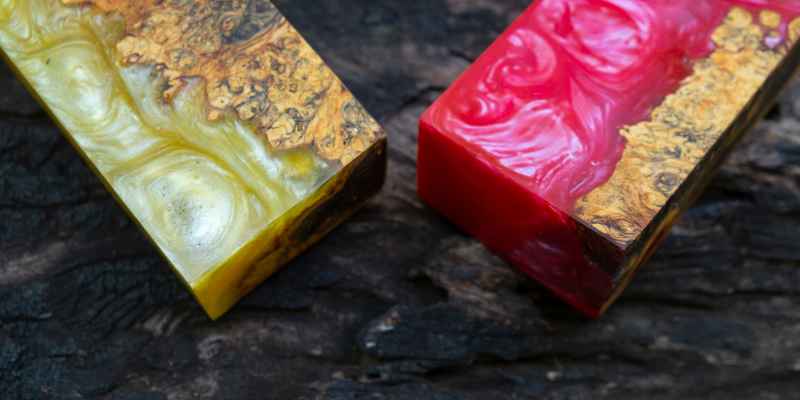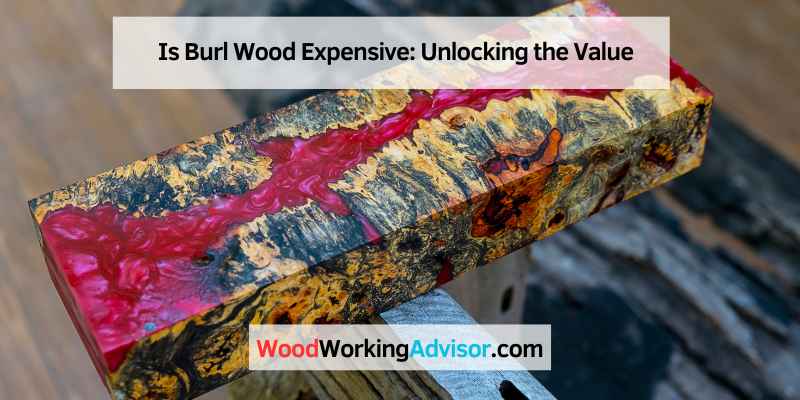Burl wood is generally more expensive than other types of wood due to its beauty and scarcity. The unique patterns and rich colors of burl wood make each piece distinct, and the natural variations ensure that no two pieces are identical.
Exploring Burl Wood
Burl wood is a rare and highly sought-after material in the woodworking industry. Its distinctive appearance and unique characteristics make it a valuable and prized resource for artisans, craftsmen, and collectors alike. In this article, we delve into the world of burl wood, exploring its rarity, appreciating its unique characteristics, and understanding its value in the market.
Understanding The Rarity Of Burl Wood
Burl wood is generally more expensive than other types of wood due to its scarcity. It forms as an abnormal growth on trees, resulting from environmental or genetic stress. This abnormality causes the wood to develop intricate patterns and rich colors, making each piece of burl wood distinct and highly prized. The natural variations ensure that no two pieces are identical, adding to its exclusivity and desirability.
Appreciating The Unique Characteristics
One of the special features of burl wood is its “wild grain,” which makes it extremely dense and resistant to splitting. This makes it an ideal material for crafting furniture and decor with unique designs. The beauty and durability of burl wood make it a popular choice for creating high-end products, contributing to its high market value.
Factors Driving Burl Wood’s Value
Burl wood is renowned for its beauty and uniqueness, making it more expensive compared to other types of wood. However, there are specific factors that contribute to the high value of burl wood. Let’s explore these factors in more detail:
Scarcity And Difficulty In Harvesting
Scarcity:
Burl wood is not commonly found in forests, making it a rare and limited resource. The growth of burl wood occurs when trees develop abnormal growths on their trunks or branches, resulting in intricate patterns and swirling grain formations. Due to its rarity, the supply of burl wood is limited, driving up its value in the market.
Difficulty in Harvesting:
Harvesting burl wood is a challenging and time-consuming process. Since burls grow as irregular formations on the exterior of trees, they require skilled craftsmen to carefully locate and extract them. The irregular shape and often large size of burls make their removal even more difficult. This labor-intensive process adds to the cost of burl wood and contributes to its high value.
Artistic And Functional Appeal
Artistic Appeal:
The distinctive patterns and unique grain formations found in burl wood make it highly sought after by artisans and furniture makers. Each piece of burl wood possesses its own individual beauty with mesmerizing swirls and colors, creating one-of-a-kind works of art. The artistic appeal of burl wood adds to its value as a premium material in the world of design and craftsmanship.
Functional Appeal:
In addition to its aesthetic qualities, burl wood also offers functional advantages. Its dense composition and resistance to splitting make it ideal for creating durable furniture and decor items that can withstand daily use. The combination of both artistic and functional appeal elevates the value of burl wood in the eyes of buyers and collectors.
Types Of Burl Wood & Their Value
Burl wood is highly sought after for its intricate patterns and rich colors, making it more expensive than other types of wood. Its scarcity adds to its value, as burl formations are unique and ensure each piece is one-of-a-kind. Celebrated for its beauty and rarity, burl wood is a prized option for furniture and decor enthusiasts.
Burl wood is prized for its unique patterns and rich colors, making it more valuable than other types of wood due to its scarcity. Let’s explore the different types of burl wood and their respective value.
Amboyna Burl
Amboyna burl is one of the rarest and most expensive veneers globally, known for its intricate patterns and small leaf dimensions. This wood is so luxurious that it was once used on Rolls Royce dashboards.
Maple Burl
Maple burl features stunning swirling patterns and vibrant colors, making it highly sought after for furniture and decor. Its scarcity adds to its overall value in the market.
Walnut Burl
Walnut burl is renowned for its dark, rich hues and intricate grain patterns. The complexity of its design and the limited availability contribute to its high price tag in the woodworking industry.
Birch Burl
Birch burl showcases a unique blend of colors and irregular grain patterns, making each piece distinctive. Its rarity and resilience against splitting make it a valuable choice for crafting high-end furniture and art pieces.
In conclusion, each type of burl wood carries its own beauty and value, attracting woodworkers and collectors alike due to its scarcity and exquisite aesthetics.
Determining Burl Wood’s Market Price
Burl wood is known for its exquisite patterns and rich colors, making it highly sought after and expensive. Each piece of burl wood is unique, with natural variations ensuring that no two pieces are identical. Its rarity and beauty contribute to its higher market price compared to other types of wood.
Factors Affecting Burl Wood Pricing
Burl wood’s market price is influenced by various factors. The unique formations found beneath the bark make each piece distinct and highly valued. Additionally, the scarcity of burl wood due to its growth from exterior burls contributes to its higher price compared to other types of wood.
Evaluating The Dollar Value
When determining the market price of burl wood, its beauty, scarcity, and intricate patterns play a significant role in its value. Burl wood’s density and resistance to splitting make it ideal for crafting unique furniture pieces and decorative items, enhancing its overall dollar worth.
Applications And Uses Of Burl Wood

Burl wood, with its intricate patterns and rich colors, is highly prized and can be found in various applications. Its unique formations make each piece of burl wood distinct, ensuring that no two pieces are identical. Let’s explore some of the popular uses of this extraordinary wood:
Furniture Making
Burl wood is widely used in furniture making due to its exceptional beauty. Its unique patterns and colors add a touch of elegance to any piece of furniture. From coffee tables and dining tables to cabinets and bed frames, burl wood furniture stands out as a statement piece in any room.
Art And Sculptures
Artists and sculptors often turn to burl wood to create one-of-a-kind masterpieces. Its natural variations and intricate patterns provide a canvas for creativity. From stunning wall sculptures to intricately carved figurines, burl wood brings art to life with its captivating aesthetics.
Utility Items
Burl wood is also utilized in the creation of utility items. Its density and resistance to splitting make it ideal for crafting functional and durable objects. From bowls and cutting boards to mallets and wooden pegs, burl wood is valued for its strength and reliability.
Overall, the applications and uses of burl wood are diverse and expansive. Its scarcity and distinctive beauty contribute to its higher price compared to other types of wood. Whether it’s used in furniture making, art, or utility items, burl wood adds a touch of luxury and individuality to any project.
Challenges In Harvesting And Selling Burls
Burl wood is highly sought after for its exquisite patterns and rich colors, making it a prized material in the woodworking industry. However, the unique nature of burls presents challenges in both harvesting and selling these valuable wood formations.
Assessing Market Demand
Understanding the market demand for burl wood is crucial for both harvesters and sellers. Due to its rarity and distinctiveness, burl wood commands high prices, but the demand fluctuates based on current trends and consumer preferences. Assessing market demand requires staying informed about design and furniture trends to ensure that harvested burls align with the current market needs.
Navigating Environmental Regulations
Harvesting burl wood must adhere to strict environmental regulations to ensure sustainable practices and the preservation of natural habitats. Navigating and complying with these regulations poses a challenge for harvesters, as improper harvesting methods can have detrimental effects on the health of the trees and surrounding ecosystems. Sellers also need to verify the legality of the sourced burl wood to avoid legal issues and maintain ethical standards in the woodworking industry.
Future Outlook For Burl Wood Industry
Burl wood is known for its uniqueness and rich patterns, making it highly prized and relatively expensive in the woodworking industry. Its scarcity and intricate features contribute to its high value, as each piece of burl wood is distinct, ensuring exclusivity in furniture and decor.
The future outlook for the burl wood industry is influenced by various factors, including the renewed interest and trends, sustainability, conservation efforts, and the overall value of burl wood in the market.
Renewed Interest And Trends
The burl wood industry is experiencing renewed interest and growing trends, driven by the appreciation for its unique and intricate patterns. Demand for burl wood products, including furniture, decor, and artisanal crafts, continues to rise as consumers seek one-of-a-kind pieces that showcase the natural beauty of burl wood. This surge in interest is contributing to the overall positive outlook for the burl wood industry, creating opportunities for artisans and businesses to capitalize on the growing market.
Sustainability And Conservation Efforts
Amid the increased demand for burl wood, sustainability and conservation efforts are becoming paramount in the industry. Conservation organizations and environmental advocates are working to ensure responsible harvesting practices and protection of burl wood sources.
By promoting sustainable forestry and ethical sourcing, the industry can mitigate the impact on natural habitats while preserving the longevity of burl wood. Embracing sustainable practices will be crucial for the industry’s future growth and continuous availability of burl wood products.
In summary, the future of the burl wood industry holds promise due to the renewed interest and trends, as well as the focus on sustainability and conservation efforts. These factors are shaping a positive trajectory for the burl wood market, presenting opportunities for stakeholders to contribute to its sustainable and responsible growth.

Frequently Asked Questions On Is Burl Wood Expensive
How Much Is A Piece Of Burl Wood Worth?
Burl wood is expensive due to its unique patterns and scarcity. Its value varies depending on its size, quality, and type of wood, ranging from a few hundred to several thousand dollars.
Why Is Burlwood So Expensive?
Burl wood is expensive due to its scarcity and intricate patterns, making each piece unique and highly prized. This rarity and exclusiveness make it more valuable than other types of wood.
What Is The Most Expensive Burl Wood?
The most expensive burl wood is Amboyna, known for its rarity and use in Rolls Royce dashboards.
What Is Special About Burl Wood?
Burl wood is valuable due to its unique patterns and rich colors, making each piece distinct. It is dense, resistant to splitting, and rare, which increases its price.
Conclusion
Burl wood is known for its beauty and scarcity, making it generally more expensive than other types of wood. The intricate patterns and rich colors found in burl wood make each piece distinct and unique. The rarity of burl wood is a significant factor in its higher price point, as burls only grow on the exterior of trees and are harder to find compared to other types of wood.
If you’re looking to invest in a truly special and luxurious piece of furniture or decor, burl wood is definitely worth considering.


